1: Facts about Google Docs banning/removing NSFW content
They’ve always done this, actually. It isn’t new, although they do go through periods where they get more stinky about it. If you really look at their terms and conditions, they tell you that while they won’t interfere with NSFW content in private files, they do reserve the right to meddle when you make that file public/share the link. The words are “you may not DISTRIBUTE adult content via GoogleDocs.”
So when you enable a shared link on a file, like below, you’re considered to be ‘distributing’ it.
As a side note, this also makes that file fair game to be fed into their AI training.
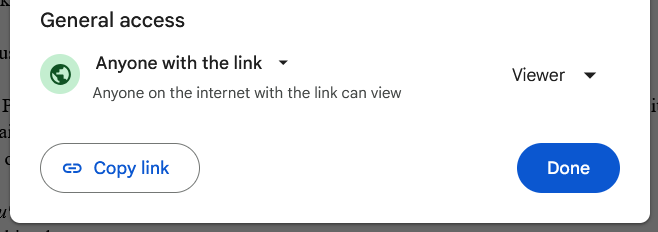
As far as I understand, sharing a file with a specific other account or several–such as editors or co-authors–does not count as public distribution.
More on how to protect yourself, back up your files and alternative services under the cut.
Keep in mind, GoogleDocs is not meant as a content distribution system. It isn’t meant as a hosting solution for people to access and read your fics, or even to share and distribute socially beneficial information like “What to do in a disaster emergency.” I say this even though I have some community-help files of my own in my Drive, and am knowingly violating their service’s intended use. This kind of file-sharing drains their resources in a way they didn’t design the service for and they don’t treat it particularly kindly–especially when they catch you with explicitly prohibited content like adult material.
2: Protect all your stuff by backing up your Google Drive
Okay, so what to do? First, a good idea ALWAYS is to periodically back up your Google Drive files.
Never ever ever ever trust that the online service you use won’t shit the bed one day and ruin that whole portion of your life. Operate on the expectation that sooner or later, that will inevitably happen, and keep backup copies of everything that matters to you.
The good news with Google Drive is that this is pretty easy! You can select files or folders and download them in a ZIP file on the spot. They’ll download as Microsoft Office documents (.docx, .pptx, .xlsx, etc), in the existing folder structure you have in your Google Drive.
Alternatively, you can use Google Takeout to request a chunk or all of your Google Drive–and more! This lets you select not only Google Drive but also other chunks of your Google account if you want them–photos, emails, blogs, and more. What’s helpful about doing it this way is that you can set it to break the files up into smaller ZIP files instead of one giant 30GB file of photos or whatever. Handy if your internet connection is begging for mercy!
Takeout can take a day or three, especially if you have a lot of data you’re requesting. When it’s done collecting the data, it will email you a download link. From there, you can click download and save the ZIP files to your computer. It does a good job of honoring your existing folder structures and file titles.
3: How to keep Google Docs from kicking your ass about NSFW content
The fact that Google Docs states they only worry about shared documents means you should (theoretically, assuming they are adhering to their own stated rules which these companies are not necessarily always doing) be able to protect yourself pretty easily by turning off ‘anyone with the link can view.’
If you have loads of files set with this–as I did–you can bulk manage it! Sort of. I say ‘sort of’ because their bulk management feature sucks. It’s still better than doing it manually per file, but bleh.
Anyway! Here’s how.
- You go into ‘My Drive’ or a sub-folder you want to manage.
- Above the list there’s a set of filter options. Click on ‘People’.
- In the dropdown, you’ll see a list of users with access to your files, and at the bottom ‘Anyone with the link.’ Select that bottom one.
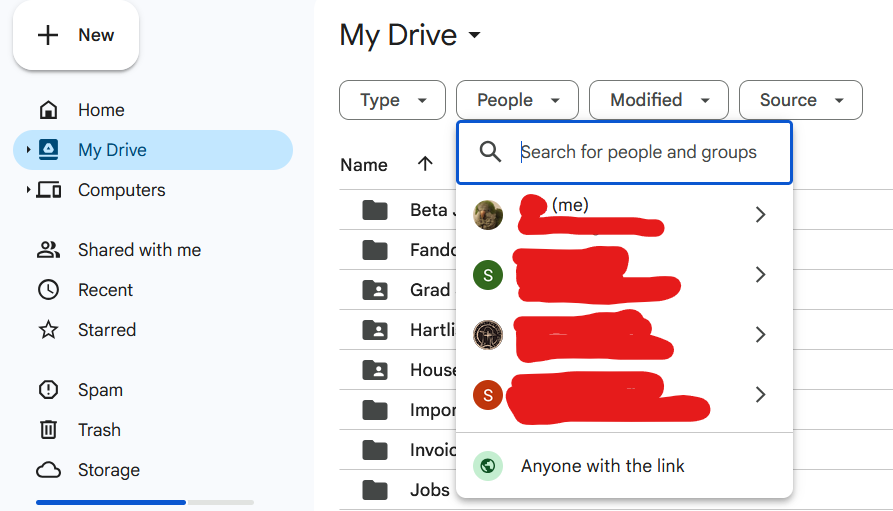
This will filter your file list to only the ones with that access permission turned on.
- Now, if you want to select all the files on the list, there’s a keyboard shortcut: CTRL + A. If you only want to select specific ones, you can hold down CTRL and click on the files you want to select.
- When you start selecting files, a context menu bar will appear at the top of the file list. When you have all your files selected, click the little person with a + sign.
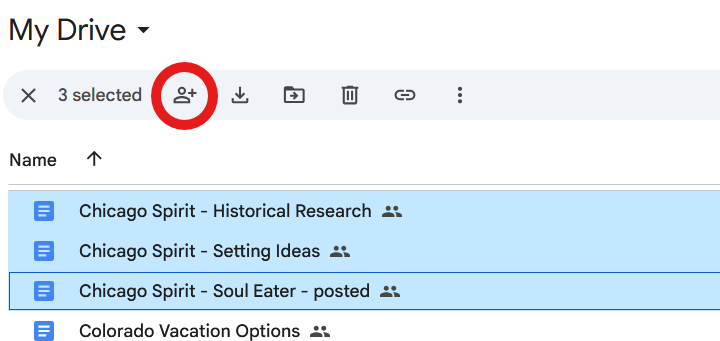
- This will open a dialogue box. Here’s the part where the bulk management will start to suck. Because this LOOKS like you should just be able to change them all using that General access setting, right? Except: it doesn’t work.
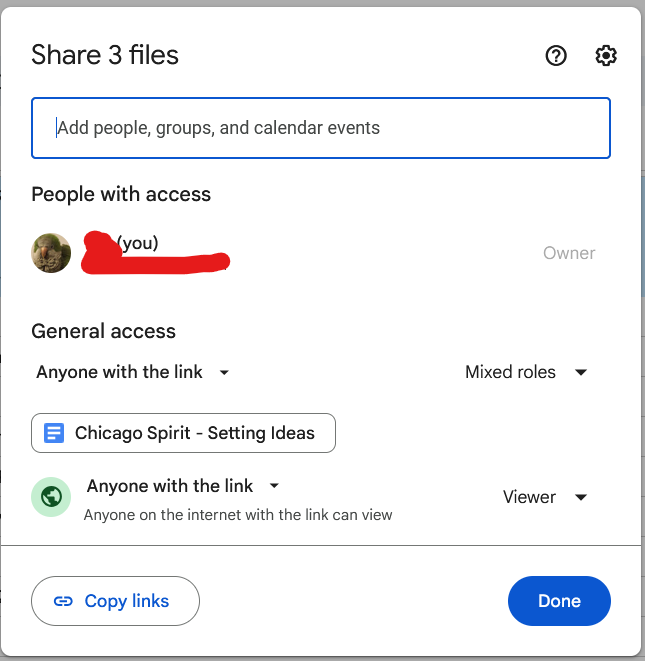
- Instead, what you have to do is look beneath it. See that button for ‘Chicago Spirit – Setting Ideas?’ That area is actually scrollable. It lists each the files you have selected with their current access permissions. Hover your cursor over it and start scrolling, and you’ll see.
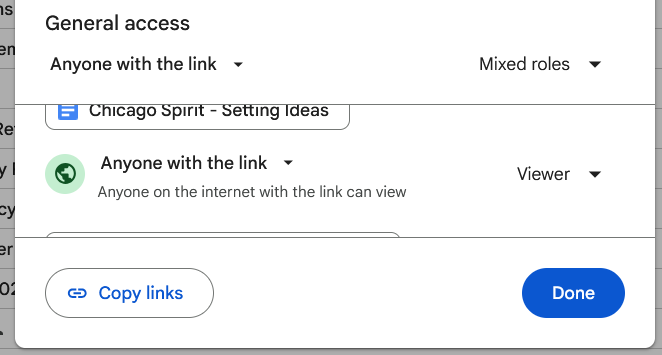
- This window is annoyingly small, and you still have to manage each file individually–but it saves you a lot of clicking. Click on that ‘anyone with the link’ beneath the file name button and it pops open a permissions dialog. Select ‘Restricted’ to turn off the public link. Keep scrolling down and doing this for each file you want to switch permissions for.
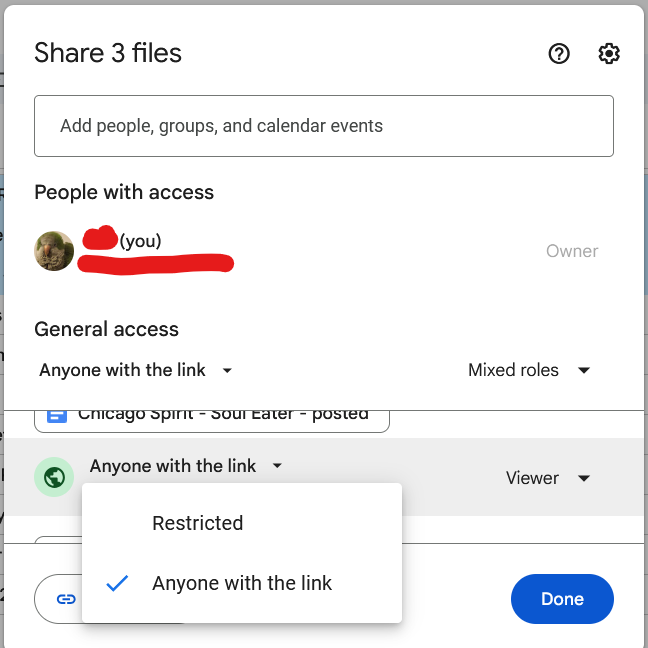
Ta da! You have cleaned up your Google Drive access permissions!
4: But what if I WANT to share my NSFW content? Where else can I go?
A couple of years ago, the answer to this question sucked. But now the landscape is much better! There are a lot of solid options. Which one is right for you can depend on your situation.
Zoho has Zoho Writer and Zoho Workdrive. Zoho Writer is a GoogleDocs-alike. Zoho Workdrive is a whole suite, including spreadsheets and the rest. Both of these offer free plans, and also very cost-effective paid plans starting at just a couple USD per month.
Proton Drive is another one that has a full suite of online office tools, including docs, spreadsheets and more. They have a free tier, they are end-to-end encrypted, and their servers are not hosted in the US (they are owned by a Swiss company). Proton is the same company that owns Proton Mail and Proton VPN. Their CEO made the news earlier this year by saying nice things about the Republicans. He’s not MAGA–he’s not even American–and whether he actually believed what he said or he was trying to curry favor with the Trump administration (ass-kissing does work with them) is debatable. But while that might make you question whether to plot revolutions using their services, the end-to-end encryption means your smut and LGBT content should be able to dwell there without disruption.
Ellipsus is one of the newer players on the scene. They do NOT offer a full suite–they’re writing only. They do offer GoogleDocs-like tools for co-writing, editing and sharing links. They’re also honestly more mobile-friendly than GoogleDocs. I like them a lot–I find their interface smooth and elegant. They declare an anti-censorship, pro-privacy ethos and currently are completely free. However, while I can’t find it now, when I signed up they did have a section on their website talking about how they expect to go to a subscription model once they come out of beta. Which isn’t bad–they seem good and they deserve to be able to pay their bills–but it’s an FYI for people who wouldn’t be able or willing to pay for the service.
CryptPad.fr is another end-to-end encrypted service with data hosted outside the US (they’re French). Again, they offer a suite of office tools including writing, spreadsheets and more–they have kanban boards, actually, that’s unusual. The other thing that’s unique about Cryptpad is that they’re actually open source. CryptPad.fe is the flagship instance, and they offer both free and paid tiers. But you could join a whole different instance hosted by someone else and get the same services for free. Or, if you’re the techy type, you could even download the software and install it yourself to host your own.
There are loads of others these days, along with apps like Evernote (made for a different purpose but it lets you write from anywhere and share it) or LibreOffice (a free open source office suite for your computer if you want Microsoft Office functionality but you hate Microsoft) or Scrivener (a writing program for your computer with extensive functionality for organizing and formatting). But that should get you started on options.
